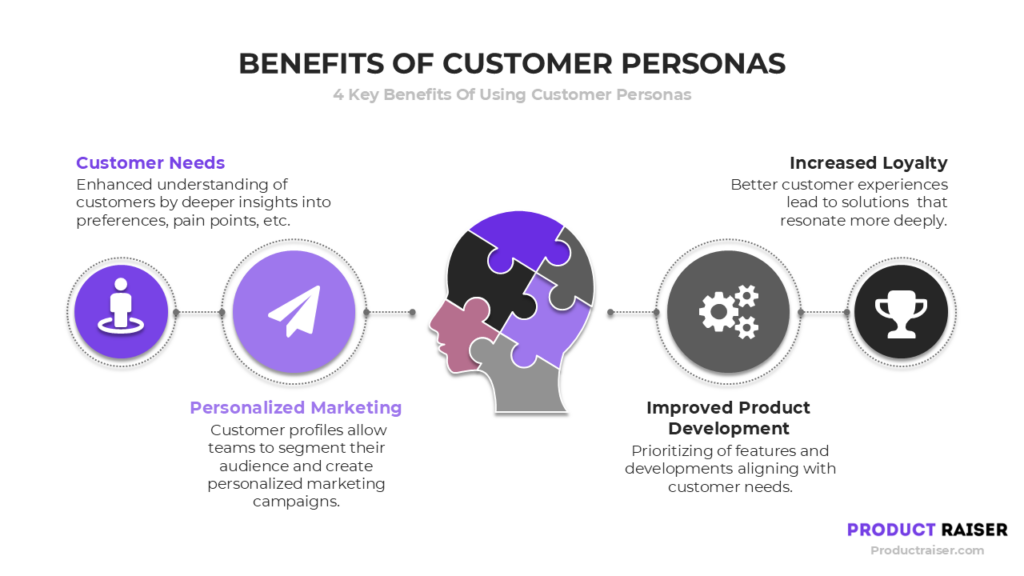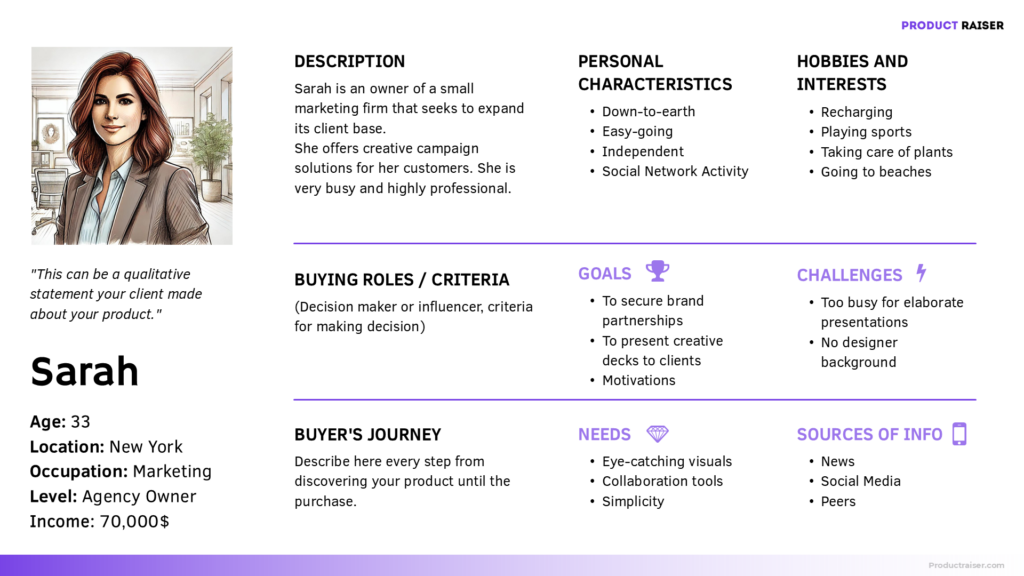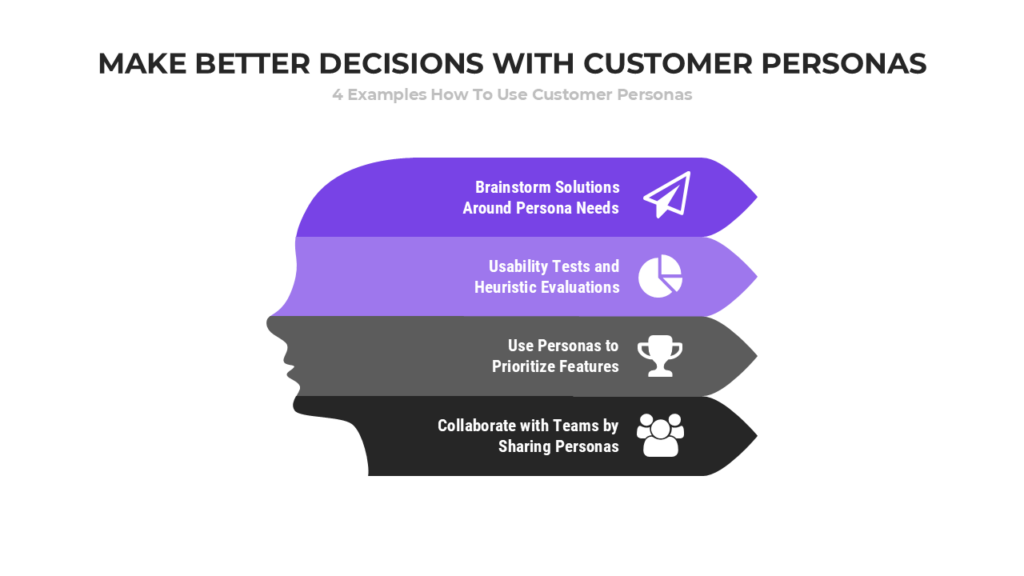Home
User Personas Made Simple: How to Understand Your Customers and Build Products They Love
Learn how to create data-driven user personas that turn guesswork into smart product decisions by gathering the right data, building accurate personas, and using them to drive your product’s success.
CHRISTIAN CASSISI – 09/27/2024

Person working on a customer persona /Dall-E
Why You Need to Know Your Customers (and How Personas Help You Make Better Product Decisions)
Meet Alex, a product manager on the verge of launching a new product. But before moving forward, Alex faces a critical question—who is this product really for?
Without a clear understanding of the target audience, Alex realizes that product success would be pure guesswork. To avoid building in the dark, Alex embarks on a journey to create user personas—fictional yet data-driven representations of his key customers. He opens Google and looks up user personas and finds the following benefits they provide:

1. Enhanced Understanding of Customer Needs: By developing detailed customer profiles, teams gain deeper insights into the preferences, pain points, and behaviors of their target audience. This understanding enables them to tailor products and services more effectively to meet customer expectations.
2. Personalized Marketing and Communication: Customer profiles allow teams to segment their audience and create personalized marketing campaigns. Personalized messages are more engaging and can lead to higher conversion rates compared to generic messaging.
3. Improved Product Development: With clear customer profiles, product teams can prioritize features and developments that align with the needs and desires of their customers. This focus ensures that resources are invested in areas that provide the most value to the target audience.
4. Increased Customer Satisfaction and Loyalty: When teams understand their customers well, they can provide experiences and solutions that resonate more deeply. This alignment leads to higher customer satisfaction, increased loyalty, and positive word-of-mouth referrals.
In this post, we’ll follow Alex’s steps to build accurate, actionable customer personas that will help you create products your audience will love. Let’s dive in and learn how you can do the same for your own products.
What Exactly Are Customer Personas?
Alex starts researching and learns that customer personas—also called user personas—are fictional representations of ideal customers, built using real data and insights. These personas guide product decisions and align marketing strategies (You will learn how to crate and use them to improve your processes soon).
Alex learns that personas help teams make informed decisions throughout the product lifecycle, ensuring better product design and more targeted marketing. For creating these, Alex considers using a user persona template to simplify the process.
Like many product managers, Alex had relied on instinct and assumptions but quickly realizes that data-backed user personas can transform the product’s success.
Get Your Free Customer Persona Template

Download our customer persona template to create detailed, data-driven profiles that will help you make smarter product decisions. Whether you’re working on product development or refining your marketing strategy, our template simplifies the process of building accurate, actionable user personas. Get your free customer persona template today and start developing products that truly meet your customers’ needs.
How to Gather Data for a Customer Persona
Alex dives into the research phase to create accurate personas. Here’s how to gather data (The order lists the most valuable source of information first, followed by the others):
1.Interviews and Surveys: Alex talks to real customers and collects feedback through surveys.
Direct input from real customers offers first-hand insights into their needs, pain points, and motivations. It’s the most reliable way to understand users because the information comes directly from them, eliminating assumptions.
2.Analytics: Using Google Analytics, Alex can see how customers currently interact with the product and identify behavioral patterns. Analytics provide quantitative data on user behavior, showing trends like which features customers use most or where they drop off. Although it doesn’t tell you why users behave a certain way, it offers solid evidence of what they do.
3.Existing Customer Feedback: Digging into customer service data, Alex spots recurring issues and needs. While customer feedback can highlight important pain points, it tends to be reactionary—users typically only give feedback when something isn’t working. It’s useful, but not as comprehensive or proactive as interviews and surveys.
4. Persona Generators: Alex uses a user persona generator to streamline some of the data processing, creating multiple personas efficiently. Tools like persona generators are helpful for organizing data and visualizing personas, but they rely on pre-existing data inputs. The tool’s accuracy depends entirely on the quality of the information you feed into it. That’s why it’s a final step after gathering solid data from interviews, analytics, and feedback.
As a free alternative to user persona generators we wrote this ChatGPT prompt to create a customer persona you can use:
ChatGPT Prompt Template for Customer Profile:
“I want to create a detailed customer persona for my business to better understand my target audience. Please create a possible user persona that can help me make my products more customer-centric and improve my marketing and communication strategy based on the business information I will provide you:
Product/Service Description: [Insert a brief description of your product or service]
Unique Selling Proposition (USP): [What makes your product or service unique?]
Challenges and Pain Points Solved: [List the challenges and pain points your product/service addresses]
Information About Existing Customers: [Provide any relevant details about your current customers (e.g., demographics, preferences, feedback)]
Additional Relevant Details: [Include any other information that might help in creating the persona, such as market research data, target demographics, industry trends, etc.]
Using this information, please help me create a detailed customer persona.”
Turn Customer Data into Personas
After gathering all this valuable data about his customers, Alex begins building user personas. It’s clear that there won’t be just one persona—there are multiple customer segments, each with different needs. To target them effectively, it’s important to narrow these personas down as much as possible, focusing on key segments that represent the largest or most valuable groups. The goal is to create personas that are as close to real customers as possible.
Armed with concrete data, Alex starts crafting fictional characters that reflect his actual users. This process isn’t about guesswork—it’s about using the insights gained from interviews, analytics, and feedback to build personas that truly represent the target audience.
During this process, Alex identifies common patterns and interests across users. For example, he notes a clear trend: customers want simplicity over complexity. This leads Alex to create a persona with the goal of “simplifying workflows”—a key feature that can drive future product development.
When creating personas, Alex focuses on the following key elements:
Demographics: Who are they? (e.g., age, gender, job)
Goals & Motivations: What do they want to achieve?
Challenges & Pain Points: What barriers do they face?
Behavior & Buying Patterns: How do they engage with products, which socials do they use, etc.?
Now it’s key to use these valuable insights and prevent guesswork and save resources like time, energy and money.
How to Use Personas to Make Better Product Decisions
With the personas in place, Alex is now able to make smarter product management decisions:

Product Development: Alex’s roadmap prioritizes features that align with Sarah’s need for simplicity, like a streamlined user interface, while James’ persona drives the development of advanced customization options. Each new feature is validated against persona goals to ensure relevance and impact.
Marketing Strategy: The marketing team tailors their messaging, focusing on time-saving solutions for Sarah while emphasizing tech-forward innovations for James. Campaigns are crafted to directly address the unique pain points and motivations of each persona, ensuring targeted and effective communication.
We’ve created a dedicated article that dives deeper into how to use personas for decision-making and product development processes—check it out here. There you will find more detailed information to the picture above.
Conclusion & Why You Should Start Your Own Persona Journey Today
At the end of the journey, Alex realizes the power of well-crafted user personas. With a deep understanding of who their customers are, Alex can now guide the product team confidently, ensuring the product meets real user needs.
Just like Alex, you too can drive the success of your product by understanding your customers through data-driven user personas. They help keep your team focused on solving real customer problems—leading to a better product and a stronger business.
Ready to create your own customer personas? Subscribe to our newsletter for templates, expert tips, and the latest tools to help you get started!
Newsletter
MORE TIPS, TEMPLATES AND EXCLUSIVE INSIGHTS
Be Ahead Of Others With Our Newest Articles
Launch your Amazon Product Successfully in 10 Steps
Learn how to optimize listings, gain reviews, and boost sales on Amazon in 2024.
What is Agile Product Lifecycle Management
Master essential Product Management KPIs to boost growth, user satisfaction, and team efficiency with data-driven insights and strategies.
Product Manager Explained
Master essential Product Management KPIs to boost growth, user satisfaction, and team efficiency with data-driven insights and strategies.
Master working with Product Management KPIs
Master essential Product Management KPIs to boost growth, user satisfaction, and team efficiency with data-driven insights and strategies.
How to Use Personas
Learn how to turn your customer personas into actionable insights that improve your product development and marketing strategies.
Everything You Need to Know About Product Management for Beginners
Unlock the secrets of successful product management and learn how to turn ideas into winning products.






